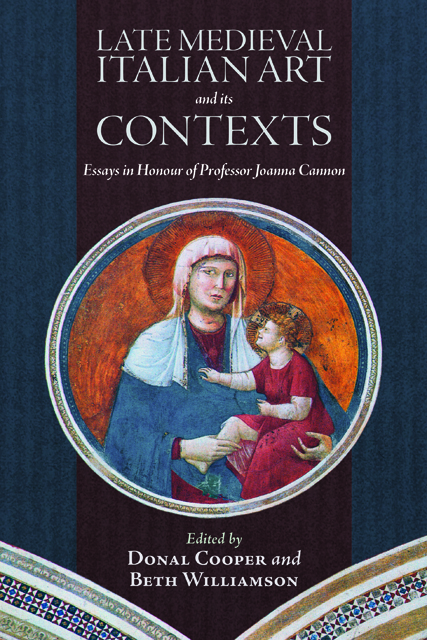Book contents
- Frontmatter
- Contents
- List of Illustrations
- List of Contributors
- Acknowledgements
- List of Abbreviations
- 1 Introduction: Circling Giotto
- 2 Holy Wood / ‘sacra tavola’: Saint Dominic and the Memory of Miracles in Bologna
- 3 The Sculpted Saint: A Statue of Saint Francis in Siena
- 4 Guccio di Mannaia and the Concept of a ‘Franciscan’ Chalice
- 5 ‘Speculum sine macula’: The Trittico di Santa Chiara in Trieste as an Object of Clarissan Devotion
- 6 The Siena Connection: A Franciscan Provincial Minister between Tuscany and Assisi at the Dawn of the Trecento
- 7 Simone Martini’s ‘Treaty with the House of Santa Fiora’ in Siena’s Palazzo Pubblico: Its Date and Significance
- 8 Crisis and Charity in Fourteenth-Century Florence: Ambrogio Lorenzetti’s Saint Nicholas Panels for San Procolo
- 9 Father of Light: Giotto and the Beatific Vision in the Baroncelli Chapel
- 10 Painter-Illuminator Workshops and the Church of San Giorgio a Ruballa: The Case of Bernardo Daddi and Pacino di Bonaguida
- 11 Patterns of Holiness: A Virgin Lactans in a Franciscan Context
- 12 A New Angle on Simone Martini’s Holy Family
- 13 Artistic Appropriation, Institutional Identity, and Civic Religion in Fourteenth-Century Siena: The Byzantine Treasury of the Hospital of Santa Maria della Scala
- 14 Visual Religious Education in Late Medieval Florence: Zanobi Perini, The Leggenda di Santo Tobia, and The Misericordia
- 15 Saints and Status in Late Medieval and Early Renaissance Florence
- Select Bibliography
- Publications by Joanna Cannon
- Index
- Tabula Gratulatoria
- Backmatter
7 - Simone Martini’s ‘Treaty with the House of Santa Fiora’ in Siena’s Palazzo Pubblico: Its Date and Significance
Published online by Cambridge University Press: 20 December 2022
- Frontmatter
- Contents
- List of Illustrations
- List of Contributors
- Acknowledgements
- List of Abbreviations
- 1 Introduction: Circling Giotto
- 2 Holy Wood / ‘sacra tavola’: Saint Dominic and the Memory of Miracles in Bologna
- 3 The Sculpted Saint: A Statue of Saint Francis in Siena
- 4 Guccio di Mannaia and the Concept of a ‘Franciscan’ Chalice
- 5 ‘Speculum sine macula’: The Trittico di Santa Chiara in Trieste as an Object of Clarissan Devotion
- 6 The Siena Connection: A Franciscan Provincial Minister between Tuscany and Assisi at the Dawn of the Trecento
- 7 Simone Martini’s ‘Treaty with the House of Santa Fiora’ in Siena’s Palazzo Pubblico: Its Date and Significance
- 8 Crisis and Charity in Fourteenth-Century Florence: Ambrogio Lorenzetti’s Saint Nicholas Panels for San Procolo
- 9 Father of Light: Giotto and the Beatific Vision in the Baroncelli Chapel
- 10 Painter-Illuminator Workshops and the Church of San Giorgio a Ruballa: The Case of Bernardo Daddi and Pacino di Bonaguida
- 11 Patterns of Holiness: A Virgin Lactans in a Franciscan Context
- 12 A New Angle on Simone Martini’s Holy Family
- 13 Artistic Appropriation, Institutional Identity, and Civic Religion in Fourteenth-Century Siena: The Byzantine Treasury of the Hospital of Santa Maria della Scala
- 14 Visual Religious Education in Late Medieval Florence: Zanobi Perini, The Leggenda di Santo Tobia, and The Misericordia
- 15 Saints and Status in Late Medieval and Early Renaissance Florence
- Select Bibliography
- Publications by Joanna Cannon
- Index
- Tabula Gratulatoria
- Backmatter
Summary
It is now over a third of a century since a fourteenth-century fresco, generally known as the New Fresco (Plate IX), was discovered at the heart of Siena’s Palazzo Pubblico, in the centre of the west wall of the building’s main council-chamber, the Sala del Consiglio, now generally known as the Sala del Mappamondo (Fig. 7.1). This remarkable work was evidently whitewashed not long after it was painted, since it occupies an area of wall covered from 1345 onwards by Ambrogio Lorenzetti’s longlost Mappamondo, the world-map which gave the room its popular name. Before this, however, the fresco had already been deliberately damaged: as the restoration campaign in 1980–81 revealed, at some stage the figures had been pelted with stones and then cancelled out with a thick layer of blue paint, leaving visible only the hill-top town on the right. And one further layer of over-painting – Sodoma’s 1530 fresco of Saint Ansanus on the left-hand side of the wall – means that only part of the image is now recoverable. The New Fresco that we see today is a resurrected fragment, an abused masterpiece that was buried and forgotten by the very government that commissioned it.
The unique, strangely mute composition of the work and its negative treatment by the Sienese themselves make the New Fresco a particularly intriguing object of historical study. It also sits right at the heart of several debates about the iconographic self-representation of the Sienese commune and the development of Sienese art in the early fourteenth century, a field that Joanna Cannon’s work has done so much to illuminate. Unfortunately, however, its interpretation has so far been dogged by controversy. As is well known, the New Fresco has been embroiled in the dispute that surrounds the famous fresco above it, the equestrian portrait known as the Guidoriccio, due to links with the so-called ‘Castle Series’, a documented set of depictions of Sienese territories displayed in the same room. All previous interpretations of the New Fresco, therefore, have been assumed to have a bearing on the so-called ‘Guidoriccio problem’, and there can be no doubt that this has hindered the proper evaluation of the image.
- Type
- Chapter
- Information
- Late Medieval Italian Art and its ContextsEssays in Honour of Professor Joanna Cannon, pp. 111 - 132Publisher: Boydell & BrewerPrint publication year: 2022



